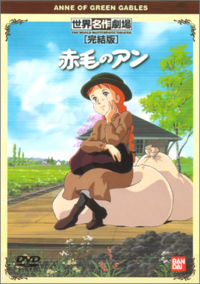
When my husband and I were in Cavendish (Avonlea), P.E.I. several years ago, we both noticed there were a lot of Japanese tourists visiting the Green Gables site. I asked one of the Japanese schoolgirls there why Anne of Green Gables was so popular in Japan, and she held her hand over her mouth and giggled.
Then another girl who could speak some English touched her own braided hair and answered, “Akage no Anne. She’s very popular in Japan. Akage no Anne means ‘Anne with red hair.'” She told me they read about Anne Shirley in their English textbooks at school.
This is a little fact I tucked away for years until I ran across this site that explains more detail. This is from the Prince Edward Island government website: Anne of Green Gables.
I’m quoting directly:
“In Japan, Montgomery became part of the school curriculum in 1952. In 1939, when New Brunswick missionary, Miss Shaw, left Japan, she gave to her friend Hanako Muraoka her prized copy of Anne of Green Gables. Secretly, the respected Japanese translator rendered Montgomery’s text into Japanese, Akage No Anne (Anne of the Red Hair).
When the Second World War ended and officials were looking for uplifting Western literature for the schools, Muraoka brought out her translation of Anne. Ever since, Anne has been a part of Japanese culture, with her exotic red hair and comic outspokenness.
Yuko Izawa’s recently published bibliography of editions gives some idea of the continuing popularity of Montgomery in Japan (see Credits under Works Cited). Today, there is an Anne Academy in Japan; there are national fan clubs; one nursing school is nicknamed “The Green Gables School of Nursing” and is sister school with the University of Prince Edward Island’s School of Nursing.
Thousands of Japanese come to Prince Edward Island every year as visitors to Anne country and the Land of Green Gables. When the National Park house called Green Gables caught fire in May 1997, the Japanese responded immediately by sending money to restore and repair the building. Dozens of glossy Japanese magazines have devoted whole issues to photographs of Island scenery and crafts and of course to the sites devoted to Montgomery and her works.”
This completely fascinates me!
As I’ve been reading through the Anne of Green Gables series this year, one thing really strikes me about Montgomery’s writing — her descriptions of setting. The beauty of Prince Edward Island is what attracts us so much to the world of Anne — and I can’t help but imagine how Japanese readers feel when they’re reading it.
Japan is densely populated, with many people living in high-rise apartments surrounded by noise and concrete. Anne’s world was one filled with beauty, quiet, nature, and peace. It’s something few of us have, yet all of us long for.






5 Responses to Akage no Anne